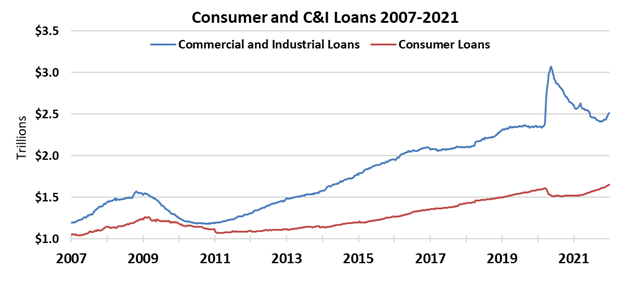Why the Fed thinks more debt is a sign to be bullish

The Federal Reserve has thrown markets into a bit of a frenzy over the last several months.
As the economy has improved and no longer needs cheap loans, the Fed has indicated it will begin raising rates. While the market initially reacted poorly to the news, this is a sign the economy has a large amount of room to run.
Today, we will be looking into how the changing debt picture spells further market appreciation, and how you should think about your portfolio in a rising rates world.
Investor Essentials Daily:
The Monday Macro Report
Powered by Valens Research
As macroeconomic data came in last month, along with banks reporting earnings, the Fed and banks are reporting on an incredibly bullish signal.
The bullish signal? Loans are growing.
After nearly two years of increased liquidity in the market, the largest banks in the nation showed more than 3% year-over-year growth.
While 3% isn’t an eye-popping number, it is the first sign of acceleration in the loan market after borrowers had lowered their aggregate debts during the liquidity rush in 2020.
Increased debt is an incredibly bullish indicator as it is a sign to investors that the economy is starting to pick up again.
For those thinking about the super leveraged balance sheets of firms in the mid-2000s before the Great Recession, it may be concerning to hear about increasing debt levels.
But the context of debt in 2007 and 2022 is completely different. Aggregate debt levels can measure this.
To explain why it serves as a bullish sign, a long-run chart of loan growth can visualize historical trends.
The chart below shows total consumer loans against commercial and industrial (C&I) loans. Looking at the C&I loans you can see that the inflection in loan growth shows a different trend than 2020.

In 2020, C&I loan growth was caused by a sudden panic for companies to ensure they had enough liquidity as the economy slowed down overnight.
Meanwhile, the steadier inflection we’re seeing today is a sign that businesses are starting to borrow to fuel growth.
The inflection consistently lines up with when a bull market gains traction because the economy takes off with it.
From looking at past cycles, there was a short-term spike in C&I loan growth in the middle of the crisis, driven primarily by a rush of liquidity.
The trend continues, as just like in previous cycles, there is a lull as borrowers digest their debts. Banks during this time must also be patient as they work through their bad loans.
After this brief lull, borrowing starts to pick up again as companies look to invest in growth.
This investment in growth becomes a big catalyst for the economy accelerating and bringing the market higher with it.
Much ink has been spilled about the high inflation rates that the economy has seen in recent times. As the primary authority on managing these inflation levels, we’d argue that the Fed may be pursuing higher interest rates because they’re looking at this same data.
They may be starting to get comfortable enough about the economy’s health to start to fight inflation aggressively. With the demand for loan growth back, interest rates do not need to be as low.
Rather, they’re seeing tangible recovery. As borrowers begin investing in the economy again, the economy is getting back on its own two feet.
And that acceleration is a reason to get bullish.
Best regards,
Joel Litman & Rob Spivey
Chief Investment Strategist &
Director of Research
at Valens Research




